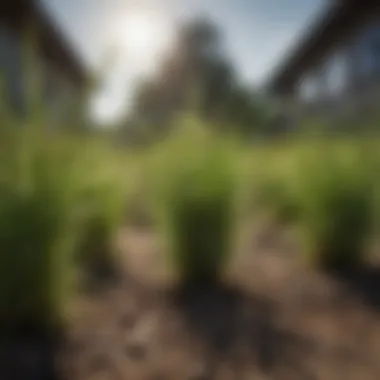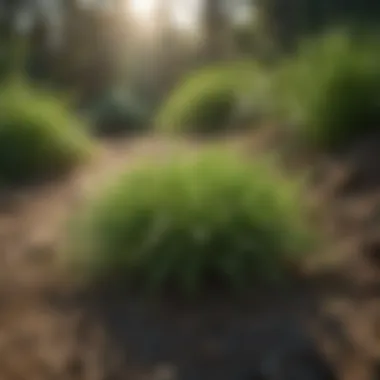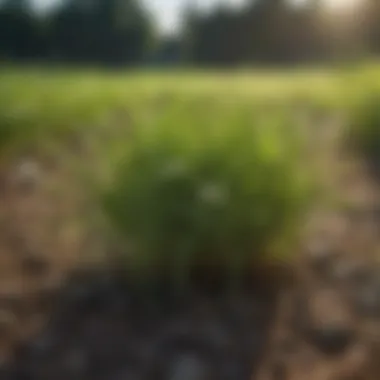Understanding XLR8 Crabgrass: Impacts on Agriculture


Intro
XLR8 crabgrass presents both challenges and opportunites for agricultural productivity and horticulture. This common weed, prevalent in many regions, can significantly impact crop yields and aesthetic quality of gardens. Understanding its biology, growth patterns, and effective management practices is critical for farmers and horticulturists alike.
Overview of the Topic
Definition and Importance
Crabgrass, particularly XLR8 variety, is a grassy weed that competes aggressively with cultivated plants. It interrupts nutrient and water uptake, negatively affecting crop performance. This weed thrives in warm weather and poor soil conditions, making it a regular adversary for many farmers.
Understanding its implications is vital for enhancing agricultural efficiency and maintaining horticultural beauty. Weeds like XLR8 crabgrass can lead to increased costs due to the need for additional resources in controlling them.
Current Trends
Recent research highlights a growing focus on sustainable practices for weed management. Farmers are increasingly looking at integrated approaches that merge chemical and cultural techniques. These methods aim to minimize environmental impact while effectively controlling crabgrass populations. Emerging innovations, such as advanced herbicides and crop rotation strategies, also provide promising avenues for better management.
Key Techniques and Practices
Step-by-Step Guide
- Identification: Recognize XLR8 crabgrass through its distinct leaf patterns and growth habits.
- Monitoring Growth: Regularly check fields or gardens for early signs of infestation, typically in the late spring and early summer.
- Cultural Methods: Implement practices such as crop rotation and mulching to deter crabgrass growth.
- Chemical Control: Use appropriate herbicides, following label instructions closely to mitigate any environmental impact.
- Ongoing Management: Continually manage emerged crabgrass through mechanical removal and consistent monitoring.
Tools and Equipment Needed
- Soil test kits
- Herbicide applicators
- Mulching materials
- Hand tools for mechanical removal such as hoes and rakes
Challenges and Solutions
Common Obstacles
Farmers may face various challenges, such as resistance to herbicides, poor timing in application, and significant competition from established crabgrass. These factors can lead to increased management costs and higher difficulty in controlling the weed effectively.
Innovative Solutions
Adapting to changing conditions requires innovation. Some effective strategies include:
- Integrated Pest Management: Combining both chemical and non-chemical methods for a holistic approach.
- Emerging Research: Following developments in genetic herbicide resistance can play a role in future solutions.
"The strategic management of XLR8 crabgrass not only boosts crop production but also promotes a more sustainable agricultural practice."
Prolusion to XLR8 Crabgrass
XLR8 crabgrass has significant implications for both agriculture and horticulture. Understanding this weed is crucial for farmers and horticulturists. Its prevalence raises concerns about crop competition and land management. In this section, we will explore what crabgrass offers and how it can impact farming practices.
By gaining insights into XLR8 crabgrass, one can develop better strategies for control. This understanding can lead to improved yields and better management of resources. It is essential to consider how this weed interacts with various crops and gardens to devise effective countermeasures.
Defining Crabgrass
Crabgrass belongs to the genus Digitaria, which comprises various species known for their rapid growth and adaptability. This weed can typically be found in warm-season areas and infests lawns, gardens, and agricultural fields. Crabgrass is distinguished by its sprawling growth form and vibrant green color. It thrives in nutrient-rich and disturbed soils, often outcompeting desirable plants for resources.
The presence of crabgrass in a field signifies certain environmental conditions. It emerges early in spring and establishes quickly. Thus, understanding its lifecycle is vital for effective management. Durable roots and an extensive growth habit allow it to thrive, making it problematic in both agricultural and horticultural settings.
The Role of XLR8 in Weed Management
XLR8, a specific variant of crabgrass, plays a notable role in weed management efforts. Understanding its unique characteristics aids farmers in developing targeted strategies. While traditional methods of control exist, XLR8 requires a more nuanced approach.
The effectiveness of XLR8 in weed management stems from its resilience and adaptability. Knowing when and how it grows allows for precise application of cultural and chemical controls. This specific variant often requires integrated strategies to limit its impact on crop yields.


Effective management practices are crucial for reducing competition with primary crops. By leveraging research on XLR8, agricultural professionals can enhance their approaches to weed control. Greater awareness of XLR8 crabgrass will lead to more sustainable practices in both agriculture and horticulture.
Biology of Crabgrass
Understanding the biology of crabgrass is essential for effective management strategies, particularly for farmers and horticulturists. Through a deep dive into the biological characteristics of crabgrass, one can establish a well-informed approach to mitigate its adverse effects on crops and gardens. The interactions between crabgrass and other agricultural systems necessitate a comprehensive grasp of its morphological traits, reproductive behaviors, and growth patterns.
Morphological Characteristics
Crabgrass, commonly referred to by its scientific name Digitaria sanguinalis, is distinguishable due to its unique morphological characteristics. The plant typically features a fibrous root system, which enhances its ability to anchor itself in various soil types. The leaves are long and narrow, often reaching up to 30 cm in length. They are distinguished by their rolled and folded arrangement in the bud stage. The upper leaf surfaces can have a slightly hairy texture, which assists in moisture retention. The stems of crabgrass are generally prostrate, allowing them to spread horizontally across the ground.
Additionally, crabgrass presents distinct seed heads. The inflorescence typically appears as a branched structure, displaying numerous spikelets. This structure enhances its reproductive capacity, as each spikelet can produce multiple seeds. Understanding these morphological features helps in identifying crabgrass early in the growing season, thereby facilitating preemptive management strategies.
Reproductive Biology
The reproductive biology of crabgrass reveals its adaptability and resilience as a weed. Digitaria sanguinalis primarily propagates through seeds, which can number up to 150,000 per plant in a single growing season. Seeds exhibit dormancy, allowing them to survive unfavorable conditions and germinate when environmental factors become optimal, such as temperature and moisture. This trait poses challenges for agricultural practices, as dormant seeds can remain viable in the soil for several years.
Crabgrass primarily reproduces by self-pollination, but cross-pollination also occurs, contributing to genetic diversity within populations. The ability to reproduce quickly and in high numbers underscores the necessity for effective control measures. Understanding reproductive cycles can inform timing for interventions, such as applying herbicides or cultural controls like mulching.
Growth Patterns
Crabgrass exhibits a growth pattern that is both aggressive and adaptive. It typically germinates in warmer temperatures, making it active during the late spring and summer months. Crabgrass competes effectively for resources, growing rapidly to take advantage of sunlight and nutrients before other plants can establish. This tendency highlights its role as a competitive weed, particularly in agricultural fields.
In terms of growth habit, crabgrass can grow upright or spread out along the soil surface, allowing it to outcompete many crops. Researchers have observed that this plant can thrive in compacted soils, shaded areas, and a variety of soil types, which makes it particularly challenging to eradicate. The staggered emergence of seedlings can also extend the growing season, presenting further management issues for crops.
"Crabgrass’ aggressive growth patterns and reproductive strategies require proactive and adaptive management efforts to minimize its impact on agriculture and horticulture."
By understanding the biology of crabgrass—its morphological traits, reproductive biology, and growth patterns—farmers and horticulturists can develop targeted management strategies that enhance sustainability and productivity. Efforts to control crabgrass are most effective when informed by a thorough comprehension of its biological characteristics.
Impact of Crabgrass on Agriculture
The impact of crabgrass on agriculture is significant. This weed affects both crop productivity and overall agricultural sustainability. Crabgrass is known for its rapid growth and ability to outcompete cultivated crops for resources such as light, water, and nutrients. Understanding its influence is crucial for farmers who aim to maintain high yields and healthy crops. Here are the main points regarding this impact:
- Resource Competition: Crabgrass can grow quickly, often overshadowing young plants. It competes aggressively for necessary resources. This can limit the growth potential of crops, leading to lesser yields.
- Disruption of Crop Management: Infestations require more management efforts. Farmers must spend time and resources combating this weed. This can lead to increased operational costs.
- Weed Population Dynamics: Once established, crabgrass can lead to a larger weed population. This complicates future weed management, requiring more intensive efforts and potential herbicide use.
The role of managing crabgrass is not just about combating a weed; it involves a comprehensive understanding of its biological traits and how it interacts with cultivated crops.
Competition with Crops
Crabgrass competes directly with a variety of crops, including corn, soybeans, and vegetables. This competition can stifle crop growth, especially in the early stages. It often takes opportunity of favorable conditions, such as warm soils, to germinate before crops do. When crabgrass emerges, it can shade and crowd crops, reducing photosynthesis and hampering overall plant health. Farmers may find that their crop yields suffer significantly in heavily infested fields.
Economic Effects on Yield
The economic repercussions of crabgrass presence cannot be overstated. Reduced crop yields translate directly to financial losses for farmers. When crops do not reach potential yields, the profit margins thin. Additional expenditures arise from increased labor for weed control and possibly more frequent herbicide applications. The economic impact can extend beyond the immediate costs; it can also affect long-term soil health. Overusing herbicides may lead to herbicide resistance, further complicating the farming landscape.
Environmental Consequences
The environmental effects of crabgrass infestation can be profound. Heavy reliance on chemical weed control methods can lead to negative consequences such as soil degradation and water pollution.
- Biodiversity Loss: Monocultures weakened by crabgrass competition might also reduce broader ecological health.
- Chemical Runoff: Herbicides used to control crabgrass can enter local waterways through runoff, impacting local ecosystems. This is critical for maintaining aquatic health.
- Nutrient Cycling: Crabgrass can alter soil nutrient dynamics, impacting other flora and fauna in the area. Its presence could foster an imbalance in nutrient availability, affecting future planting seasons.
Management Strategies for Crabgrass
Effective management of XLR8 crabgrass is critical for maintaining agricultural productivity and horticultural quality. Crabgrass can quickly become dominant in fields and gardens, leading to reduced crop yields and increased management costs. In this section, we will discuss various strategies to manage crabgrass effectively, focusing on cultural control methods, chemical control options, and integrated approaches. Each method has its characteristics, advantages, and disadvantages that can influence its effectiveness depending on the specific agricultural or horticultural context.
Cultural Control Methods
Crop Rotation


Crop rotation is a fundamental practice in sustainable agriculture. It involves alternating the types of crops grown in a particular area in sequenced seasons. This strategy disrupts the life cycle of crabgrass, making it more difficult for the weed to establish itself. A key characteristic of crop rotation is diversity. Planting different crops can help reduce nutrient competition and decrease soil-borne diseases.
One advantage of crop rotation is its ability to manage weed populations without relying solely on herbicides. This method can be particularly beneficial in reducing the build-up of crabgrass seed banks in the soil. However, crop rotation requires careful planning regarding the types of crops selected and their compatibility with the local ecosystem.
Mulching Techniques
Mulching involves the application of a layer of organic or inorganic material on the soil surface. This technique is useful for suppressing crabgrass by blocking sunlight and hindering its growth. A notable characteristic of mulching is its dual function. It not only controls weeds but also improves soil moisture retention and temperature regulation.
Organic mulches, such as wood chips or straw, can decompose over time, enhancing soil fertility. Mulching is a popular choice because it presents a low-impact and sustainable method for crabgrass management. The main disadvantage is the initial labor and material costs, which can vary based on the type of mulch used.
Optimal Planting Times
Planting crops at the right time can significantly impact crabgrass competition. This method focuses on timing the sowing of crops to outpace crabgrass emergence. A key aspect of optimal planting times is understanding the life cycle of crabgrass. Typically, crabgrass germinates in warmer soil temperatures, so planting earlier can give crops a head start.
The advantage of this method is that it requires no additional inputs. However, variability in weather conditions can affect the germination rates of both crops and crabgrass, making it essential to monitor conditions carefully.
Chemical Control Options
Pre-emergent Herbicides
Pre-emergent herbicides prevent crabgrass seeds from germinating. These products create a chemical barrier in the soil that halts seedling development. The key characteristic of pre-emergent herbicides is their timing; they must be applied before the seeds germinate. This proactive approach can significantly reduce the crabgrass population.
They are a popular choice in both agricultural and horticultural settings, primarily due to their effectiveness in controlling crabgrass early in the season. However, if applied incorrectly, these herbicides can affect other desired crops, leading to potential yield loss. Additionally, timing applications based on weather conditions requires careful observation.
Post-emergent Herbicides
Post-emergent herbicides target crabgrass plants after they have emerged. These products are typically systemic and work by being absorbed through the leaves, inhibiting the plant's growth. The main characteristic of these herbicides lies in their flexibility. They can be applied at various times during the growing season.
Post-emergent herbicides can be effective in controlling crabgrass populations that have become established. However, they may necessitate multiple applications to achieve satisfactory control. Some varieties can pose risks to non-target plants, which requires careful application and monitoring.
Integrated Weed Management Approaches
Integrated weed management approaches combine multiple strategies to achieve greater effectiveness in controlling crabgrass. This can include the use of both cultural and chemical methods. A holistic approach often yields more sustainable outcomes by reducing reliance on any single control method.
In summary, understanding the dynamics of XLR8 crabgrass and employing diverse management strategies is critical for farmers and horticulturists. By integrating cultural controls, chemical options, and holistic management techniques, one can address the challenges presented by crabgrass in both agricultural and horticultural settings.
Innovations in Crabgrass Research
Innovations in crabgrass research represent a pivotal area within contemporary agricultural practices. As XLR8 crabgrass continues to pose significant challenges, ongoing research reveals novel methods and insights that can reshape agricultural approaches. Understanding these innovations is crucial, not only for enhancing crop yield but also for advancing sustainable farming methodologies. Through genetic studies, technical advancements in herbicides, and exploration of alternative control methods, stakeholders can address the pressing concerns posed by crabgrass effectively.
Genetic Studies on Crabgrass
Genetic studies on crabgrass are currently leading to significant breakthroughs. Scientists focus on identifying the genetic traits that contribute to the resilience of XLR8 crabgrass in various environmental conditions. This understanding helps in developing targeted strategies for its management.
Understanding the genetic diversity within crabgrass populations allows researchers to harness this information for more effective control measures. For instance, identifying specific genes associated with herbicide resistance can guide the creation of new herbicides that target unique vulnerabilities in the weed’s genetic makeup. These findings could provide agricultural farmers tools that reduce reliance on broad-spectrum herbicides, minimizing the risk of environmental contamination.
Advancements in Herbicide Technologies
Advancements in herbicide technologies are transforming the way crabgrass is managed. New formulations are designed to be more effective at lower dosages, ensuring they target XLR8 crabgrass with greater precision while limiting harm to non-target species. Increased understanding of herbicide impact at various life stages of crabgrass is enabling this refined approach.
Furthermore, some recent developments include the introduction of herbicides that can be activated by specific environmental cues. This technology allows for selective application, reducing the need for repeated treatments. Consequently, such herbicide advances support sustainable agricultural practices, as they mitigate chemical runoff and preserve soil health.
Alternative Control Methods
Research into alternative control methods for crabgrass is gaining importance as farmers search for environmentally friendly solutions. These methods can include biological control agents, such as introducing natural predators or pathogens specific to crabgrass. Employing these strategies can reduce herbicide dependence while maintaining effective weed management.
In addition to biological methods, integrating technology like precision agriculture can influence crabgrass management significantly. Farming practices that use data analytics to optimize the timing and method of crabgrass control can enhance the efficacy of both chemical and cultural methods.


Overall, the pursuit of innovation in crabgrass research serves as a beacon for both agricultural and horticultural practices. It reinforces the necessity of proactive research that is adaptable to changing environmental conditions and farming needs, ensuring food production remains robust against invasive weed threats.
"Through innovation, farmers can better manage crabgrass, ensuring that agriculture remains productive and sustainable."
In summary, the exploration of genetic traits, improved herbicide technologies, and alternative methods provides a comprehensive approach to tackling crabgrass. As these tools become more available, they will undoubtedly enhance the resilience of agricultural systems against robust weeds like XLR8 crabgrass.
Case Studies of Crabgrass Management
Understanding how to effectively manage XLR8 crabgrass involves analyzing real-world applications. Case studies provide valuable insights into the effectiveness of different strategies in various settings. By examining these real-life examples, farmers and horticulturists can adopt best practices, avoid pitfalls, and refine their management approaches accordingly.
Successful Agricultural Practices
Case studies in agriculture reveal a range of successful practices for managing crabgrass. These practices often encompass a combination of cultural and chemical methods tailored to specific crops and local conditions. For instance, a study conducted in the Midwest showed that implementing a crop rotation strategy significantly reduced crabgrass infestation. Farmers alternated between corn and soybeans, which disrupted crabgrass growth cycles and minimized seed bank replenishment in the soil.
Moreover, the use of mulching techniques in these case studies emphasized the importance of organic materials. By applying straw or wood chips around crops, farmers could suppress crabgrass emergence while enhancing soil quality. Field trials suggested that areas with mulch had a dramatically lower density of crabgrass compared to untreated plots.
Other studies focused on the timing of planting as a factor in crabgrass management. Early planting of crops in the spring was shown to lead to less competition with crabgrass due to timing discrepancies in their germination. This proactive approach allowed crops to establish before crabgrass became a significant threat. These tactics illustrate the adaptability and thoughtfulness necessary in agricultural environments when dealing with persistent weeds like crabgrass.
Urban Horticulture Strategies
Urban horticulture also encounters challenges from crabgrass, yet innovative management strategies derived from case studies can enhance outcomes. In urban gardens, practitioners have found success by utilizing integrated weed management approaches. For example, community gardens in urban settings often embrace manual removal techniques. Regular weeding schedules, when combined with educational outreach, equip gardeners with the skills to maintain healthy plots.
Additionally, incorporating native plant species in urban landscapes has proven effective. Case studies indicate that these plants can naturally outcompete crabgrass. Native species tend to establish faster and thrive in local conditions, thus reducing the need for chemical interventions. Their biodiversity also supports local ecosystems, leading to broader ecological benefits.
Finally, studies highlight the relevance of urban outreach programs. Through workshops and seminars, urban gardeners can share successful strategies and learn from one another's experiences. These interactions foster a sense of community while addressing the practical realities of crabgrass management.
"Case studies reveal how adaptive management practices can lead to significant reductions in crabgrass populations, supporting both agricultural productivity and urban horticultural aesthetics."
Future Directions in Crabgrass Research and Management
In understanding the future directions in crabgrass research and management, it is essential to highlight the significance of continuous innovation in both scientific inquiry and practical application. The agricultural sector faces escalating challenges from invasive weeds like XLR8 crabgrass, necessitating a proactive approach. As such, research must focus on embracing new technologies, developing sustainable practices, and cultivating a deeper understanding of weed ecology. This evolving landscape offers various benefits, including improved crop yields, reduced environmental impact, and enhanced farmer resilience against weed infestations.
Emerging Trends in Weed Science
Emerging trends in weed science reflect an ongoing commitment to enhancing weed management strategies through a multidisciplinary approach. Recent advancements in molecular biology and genetics have opened new avenues of research. For instance, understanding the genetic makeup of XLR8 crabgrass can lead to the development of more effective control measures. Precision agriculture technologies, including drones and satellite imagery, allow farmers to monitor weed growth more accurately, facilitating targeted interventions. Moreover, the integration of data analytics into weed management equips farmers with actionable insights for optimizing their practices. These trends underline the shift towards a more precise and data-driven approach to weed management in agriculture.
Regulatory Considerations for Herbicide Use
With the growing scrutiny on chemical use in agriculture, regulatory considerations for herbicide use are becoming increasingly important. Farmers must navigate a complex landscape of regulations that dictate what substances can be applied, in what quantities, and under which conditions. This is particularly pertinent in the context of XLR8 crabgrass management, where inappropriate herbicide use can lead to resistance development and environmental harm. Staying informed about local regulations helps farmers make compliant and responsible choices. Furthermore, advocating for balanced policies that support both agricultural productivity and environmental safety is essential in this evolving landscape.
Sustainable Practices Moving Forward
Sustainable practices are crucial for effective crabgrass management while minimizing adverse environmental impacts. Incorporating crop rotation, cover cropping, and integrated pest management creates a holistic approach to tackling weed growth. Farmers can leverage these methods to enhance soil health, promote biodiversity, and reduce reliance on chemical inputs. Education and training in innovative practices, such as using biological controls, will play an integral role in shaping sustainable methods. The commitment to stewardship of both land and resources is paramount in ensuring that agricultural practices remain viable and resilient in the face of challenges like XLR8 crabgrass.
"Sustainability is not just a goal; it's a continuous journey in refining agricultural practices to meet future demands."
Ending
The conclusion of this article focuses profoundly on the critical insights derived from the study of XLR8 crabgrass. It is crucial to state that crabgrass is not merely an agricultural nuisance but an organism that impacts both crop yield and horticultural practices. Managing this weed effectively can enhance productivity significantly.
Summarizing Key Findings
Through various sections, we have examined the complexities surrounding XLR8 crabgrass. Key findings include:
- Biological Traits: Understanding the physical and reproductive traits of crabgrass contributes to better management strategies.
- Impact on Agriculture: The competitive nature of crabgrass reduces crop yield, presenting significant economic repercussions.
- Management Practices: A combination of cultural and chemical control methods can mitigate the negative impacts.
These findings synthesize critical information that not only highlight the challenges posed by crabgrass but also the strategies to combat it.
Implications for Agricultural Practices
The implications for agricultural practices are multifaceted. Recognizing the significance of XLR8 crabgrass leads to:
- Informed Decision-Making: Farmers can choose the right management strategies that align with their specific conditions, improving results.
- Sustainable Practices: Emphasizing integrated weed management fosters sustainability in agricultural practices, thereby contributing to long-term viability.
- Research and Innovation: A commitment to ongoing research will keep farmers equipped with the latest methodologies in weed control, ensuring they do not fall behind as scientific understanding evolves.



